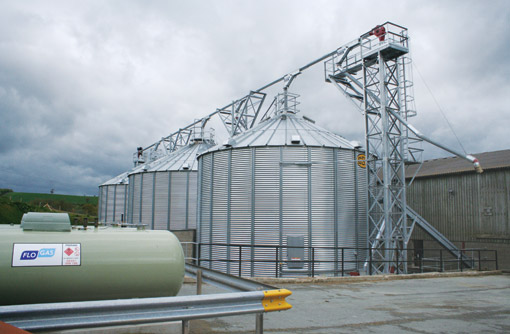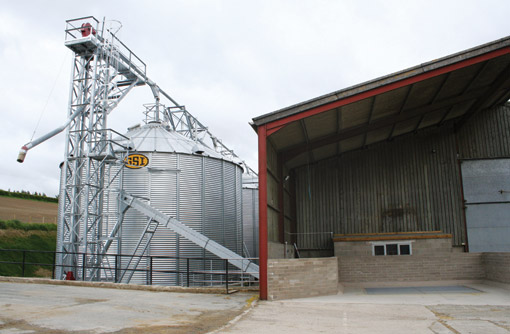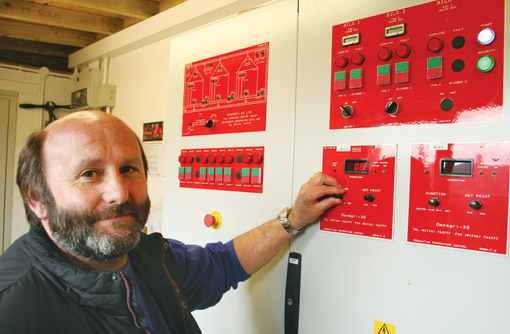Upgrade of tired grain dryer helps harvest progress

Upgrading tired grain handling facilities has streamlined harvest for one Shropshire estate, as Peter Hill discovers.
Last summer’s harvest was every bit as challenging for farm manager Clive Juleff and his team as for growers pretty much everywhere, but at least handling and drying of incoming grain was easier than in previous years.
The benefits are being felt this harvest time, as Mr Juleff, manager at W Plowden Farms, no longer has two dryers with separate intakes to manage and 18 small bins to fill, just a gleaming trio of drying silos served by one easily accessible pit.
“It means I no longer have to spend most of my time managing the drying process – and most of the night getting grain cleared ready for combining the next morning,” he says.
“The new installation has given us better facilities and the capacity we needed to cope with an increased arable acreage,” Mr Juleff adds.
With 234ha brought back in-hand last year following a tenant’s retirement, arable cropping on the Plowden Estate in south Shropshire grew to more than 400ha.
“We wanted the capacity to cope with this bigger acreage without taking on extra staff, apart from an additional seasonal worker at harvest,” notes Mr Juleff.
“We progressively increased our tractor power in anticipation and introduced min-till for crop establishment,” he adds.
For harvesting, combine capacity was upgraded to 30t/hr and to match it, intake and drying capacity had to be doubled.
The arable operation, centred on Folly Farm near Lydbury North at the western end of the estate, typically grows 180ha of winter wheat. With ambitions to simplify cropping and management, the future of the modest amount of Solstice milling wheat hangs in the balance.
Autumn- and spring-sown oilseed rape, spring barley and winter oats are also part of the mix – with rather more spring crops in the ground because of the dire weather last autumn and oilseed rape failures.
In previous years, crops have been prepared for storage using an Allmet continuous flow dryer and a Shivvers in-bin dryer before being conveyed into a set of 10 silos of 50t capacity, and another eight holding just 28t apiece.
“That’s a useful set up when you want to keep a lot of crops and varieties separate, but when you’re supplying a bulk feed market, variety segregation is unnecessary,” Mr Juleff suggests.
“It means I no longer have to spend most of my time managing the drying process – and most of the night getting grain cleared ready for combining the next morning
“Clive Juleff
Options for the replacement scheme included a bigger continuous flow dryer with either new bin storage or a new floor store. The GSI drying silo option from Danagri-3S was chosen on grounds of cost and ease of management.
“Apart from needing a new building taking up more space, a floor store would have involved more conveyors and elevators, and arguably more management,” points out Mr Juleff.
“The silo installation has an intake conveyor, a transfer conveyor to the shed alongside, and a continuous grain pump, that’s all,” he says.
“We use two of the silos as batch dryers for the earlier crops, which are stored in an adjoining shed or one of our existing bins, Then the wheat goes in, it’s dried and cooled, and just stays there,” he adds.
A significant sum was spent upgrading the electricity supply to the site, but a roof-mounted 50kW solar panel system will help offset this cost and future energy charges.
The store intake, housed in an existing lean-to that provides about 35t buffer capacity to help keep trailers moving. The pit itself is one of the first to use the new Jema Dry Pit installation. The 4m long, 3m wide galvanised steel structure is suspended from beams set into a rectangular concrete lining with vertical sides.

An existing lean-to that used to house a portable dryer now has a retaining wall around the pit to hold up to two trailers’ worth of grain. An inclined chain and slat conveyor feeding the up-and-over grain pump continuous conveyor that fills and empties the three silos.
“Our high water table and rain blowing in through the open sides of the lean-to or running down the inclined section of the conveyer means we inevitably get water ingress,” says Mr Juleff.
“But the Dry Pit design keeps the elevator clear of any water, which I pump out two or three times in winter. Also, there’s plenty of space to adjust the conveyor tensioners or even take the conveyor out if necessary,” he adds.
There is sufficient height beneath the conveyor’s discharge point for a cyclone cleaner to be added as it feeds the Hutchinson grain pump.

In-silo batch drying is different from managing a continuous flow dryer, says Clive Juleff, especially as spear sampling is needed to check that theoretical moisture extraction based on grain temperature is happening in practice. Tryac control panels operate the drying system installed in two of the silos, and the Hutchinson grain pump continuous conveyor used to fill and empty them.
This continuous tubular conveyor is used for both filling and emptying the silos – it runs beneath them, then up and over the top – with cable pulleys opening and closing the outlet slides. Powered by a 40hp electric motor, it has up to 60t/hr conveying capacity.
The GSI FCDL silos with large 4in corrugations comprise a 36ft diameter bin positioned closest to the intake and equipped with a triple-auger DMC stirring system.
It can dry a minimum of 100t – sufficient crop depth is needed to prevent the free-hanging augers from wobbling about – and to 420t, making it useful for drying the smaller acreage crops before storing up 560t of grain with the stirrer system buried.
A similarly-equipped 42ft silo can dry grain in 150t to 580t batches and will hold 780t of dry grain, and the third silo is the same size, but with only the infrastructure in place for drying and stirring, which can be added later if further capacity is needed.
All three silos have power spreaders to give an even fill and 8in Powersweep augers for unloading, with extra outlets installed to minimise the amount of blowing or sweeping needed to clear the drying floor.
Grain lorries are filled either under cover from the transfer conveyor in the adjoining floor store or outside straight from the grain pump.
W Plowden Farms – 2013 cropping area
- 178ha winter wheat – Santiago, Diego, Grafton and Solstice
- 100ha winter oilseed rape – Astrid, Compass, Quartz and NK Grandia
- 23ha spring oilseed rape – Clipper
- 58ha winter oats – Mascani and Gerald
- 52ha spring barley – Tipple
The drying process is managed by setting the required temperature: “The typical recommendation is 60C for feed wheats and 45-50C for milling wheats and oilseed rape,” says Mark Unitt of Danagri-3S.
“You can expect up to 2% moisture removal from feed wheats throughout the whole bin in 24hrs using heat and the stirrers; once down to about 14.8% moisture, it’s best to turn off the heater and let the rest come out during the cooling process.”
Managing the system does take a bit of getting used to after a continuous flow dryer, says Mr Juleff.
“With continuous flow, you can predict with some certainty that it will take, say, an hour to complete a run because you have the moisture content of the grain going in and coming out,” he explains.
“With in-silo batch drying, you have to take regular spear samples to monitor the drying progress,” he adds.
A concern that putting wet grain on top of drier grain might result in layers at different moisture levels has been dispelled.
“The stirring augers, which traverse and circulate inside the silo, do mix the layers a bit at a time,” says Mr Juleff.
“I’ve also learned the hard way how much moisture is taken out as the grain is quickly cooled – we lost half a percent needlessly from one batch; but that’s all part of the learning curve.”
Keep your grain dryer in tip-top condition

